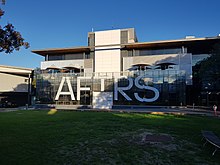Australian Film, Television and Radio School
 AFTRS building | |
| Motto | "Leading the Way- Behind the Scenes Training" |
|---|---|
| Type | Film school |
| Established | 1973 |
Academic staff | Film, television and radio |
| Undergraduates | Bachelor of Arts (Screen) |
| Postgraduates | Grad Cert, Grad Dip, MSA, MAR, MSAB |
| Location | , , 33°53′41″S 151°13′43″E / 33.8946°S 151.2285°E |
| Campus | The Entertainment Quarter, Moore Park |
| Website | aftrs |
The Australian Film, Television and Radio School (AFTRS) is Australia's national screen arts and broadcast school. The school is an Australian Commonwealth government statutory authority. It is a member of the "Australian Roundtable for Arts Training Excellence".[1]
AFTRS focus is to advance the success of Australia's screen arts and broadcast industries by developing the skills and knowledge of talented individuals and undertaking research.
History
Established in 1972 with the name of "Australian Film and Television School"[2] as part of the Commonwealth Government's strategy to promote the development of Australia's cultural activity, the AFTRS was opened to students in 1973 with the first intake of 12 students including directors Gillian Armstrong, Phillip Noyce and Chris Noonan.
In 1973 Jerzy Toeplitz was appointed Foundation Director of the School and after six years in the role was awarded the Order of Australia and the AFI's Raymond Longford Award.
In 1975 Gough Whitlam helped to create funding agencies to support the film school.
Academy Award success
Four AFTRS Student Films have been nominated for Academy Awards®:[3]
- 'Inja' (2000) Directed by Steve Pasvolsky. Produced by Joanne Weatherstone.
- 'Birthday Boy' (2003) Directed by Sejong Park. Produced by Andrew Gregory
- 'The Saviour' Directed by Peter Templeman. Produced by Stuart Parkyn
- 'Emily' Student Academy Award (2010) Directed by Ben Mathews. Produced by Simon Moore
Four AFTRS Alumni winners of Academy Awards®
- Jane Campion: Best Original Screenplay,'The Piano'
- Andrew Lesnie: Best Achievement in Cinematography,'The Lord of the Rings'
- Dion Beebe: Best Achievement in Cinematography,'Memoirs of a Geisha'
- Peter Grace: Best Sound Mixing, 'Hacksaw Ridge'
Five AFTRS alumni nominated for Academy Awards®
- Dion Beebe: Best Achievement in Cinematography,'Chicago'
- Jane Campion: Best Director, 'The Piano'
- Chris Noonan: Best Director, 'Babe'
- Pip Karmel Best Editing, 'Shine'
New school
For many years AFTRS was located in purpose-built premises at North Ryde, Sydney. In 2008 the school relocated to a purpose-built facility adjacent to Fox Studios, located inside the Entertainment Quarter in Moore Park Sydney.

AFTRS is the only screen and broadcast school in the world to cater for all of the specialisations under the one roof. The campus includes: a Full size 5.1 sound theatre (seats 126), state-of-the-art mix theatre, two large professional film and television studios, film studios, state-of-the-art sound recording studios, ten sound editing suites, four screen music composition suites, offline and online editing suites, Video-post department that provides broadcast quality dubbing, HD Avid Adrenaline online editing, Scenarist DVD authoring, web streaming and multicam production services, computer labs, tech store, props store & costume support, Grip trucks with Movietech Arco dolly and accessories, Stand-by Props truck, production design construction workshop, three on-air digital radio broadcasting studios. [4]
Courses and admission
Admission into AFTRS degree courses is competitive and based on merit selection. Places are limited. Current offerings include:[5]
- Master of Screen Arts (full-time)
- Graduate Certificates in areas of specialisation (part-time)
- Undergraduate degree: Bachelor of Arts (Screen) with fourth year honours (full-time)
- Diplomas and Advanced Diplomas in specialist craft areas for specific (part-time)
Executive staff
- CEO: Neil Peplow[6]
- Chief Operations Officer: Ann Browne
- Director of Award Courses: Martin Brown
- Director of Technology & Infrastructure: Vacant
- Director of AFTRS Open Short Courses: Liz Hughes
Teaching staff
Screen: Sarah Stollman, Samantha Lang, Catherine Gleeson, Marty Murphy, Robert Klenner, Matthew Campora, Andrew Belletty, Nell Greenwood, Rachel Landers, David Court, Gabiann Marin, Martin Armiger, Kim Batterham, Mark Warner, Gail Sky King, Steve Vidler, Daphne Paris, Erika Addis, Marian McGowan
Radio: Lisa Sweeney, Fyona Smith, Katya Quigley[7]
Alumni
The entire list of AFTRS graduates by year, from 1973 to now, can be viewed on the School's website:[8]
TV
Directing
- Gillian Armstrong
- Alex Proyas
- Jane Campion
- Phillip Noyce
- Rolf de Heer
- Rowan Woods
- Daniel Krige
- Mario Andreacchio
- Michael James Rowland
- Ivan Sen
- Alister Grierson
Producing
Screenwriting
Cinematography
Editing
Composing
Design
Radio
Notes
- ^ "Arts training bodies". 2008-09-15. Archived from the original on 2008-08-21. Retrieved 2008-10-03.
{{cite web}}: Cite uses deprecated parameter|authors=(help) - ^ Australian Film and Television School Act 1973, legislation.gov.au. Retrieved 12 June 2019.
- ^ "Archived copy". Archived from the original on 2014-12-15. Retrieved 2014-10-21.
{{cite web}}: CS1 maint: archived copy as title (link) - ^ "Facilities & Gear - Australian Film Television and Radio School". aftrs.edu.au. Retrieved 2016-12-23.
- ^ "HOME - Australian Film Television and Radio School". aftrs.edu.au. Retrieved 2016-12-23.
- ^ "AFTRS Executive - Australian Film Television and Radio School". aftrs.edu.au. Retrieved 2016-12-23.
- ^ "People - Australian Film Television and Radio School". Retrieved 2016-12-23.
- ^ "Graduates by Year - Australian Film Television and Radio School". aftrs.edu.au. Retrieved 2016-12-23.
